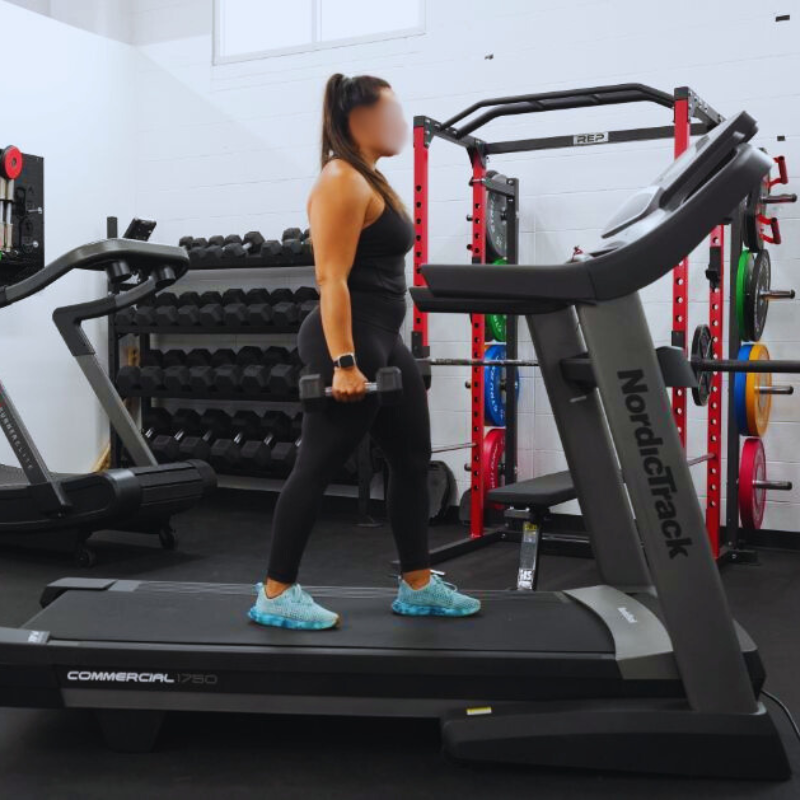Ready to turn your treadmill session into a full-body transformation? Walking on a treadmill with weights isn’t just another workout—it’s your secret weapon for simultaneously torching calories and building strength. Imagine combining the cardiovascular benefits of walking with the muscle-sculpting power of resistance training, all within the comfort of your home or gym. This isn’t just exercise; it’s efficiency in motion.
Fitness is not about being better than someone else; it's about being better than you used to be.
But before you grab those dumbbells and hop on the treadmill, there’s an art and science to doing this effectively and safely. Our comprehensive guide will walk you through everything you need to know about walking on a treadmill with weights—from selecting the right equipment to mastering techniques that maximize your workout’s potential.

Understanding the Benefits of Weighted Treadmill Workouts
When you add weights to your treadmill routine, you’re not just walking—you’re transforming your workout into a powerful, full-body experience. Let’s break down the incredible benefits that make walking on a treadmill with weights a game-changer for fitness enthusiasts.
Supercharged Calorie Burning
Imagine torching calories like a metabolic furnace! By incorporating weights into your treadmill session, you’re essentially turning up your body’s energy expenditure. Weighted walking can increase calorie burn by 20-40% compared to traditional walking, making it a stealth weapon for weight management.
- Increases metabolic rate
- Enhances post-workout calorie burn
- Challenges multiple muscle groups simultaneously
Strength Training Meets Cardio
Who says you need separate cardio and strength training sessions? Walking on a treadmill with weights brilliantly combines both, creating what fitness experts call a “hybrid workout”. This approach allows you to build muscle endurance while improving cardiovascular fitness—talk about working smarter, not just harder!
Efficiency is doing things right; effectiveness is doing the right things.
Muscle Engagement and Improved Coordination
Adding weights doesn’t just make your workout harder—it makes it smarter. When you carry weights while walking, you’re recruiting more muscle fibers, especially in your core, arms, and shoulders. This increased muscle activation leads to better overall body coordination and functional strength.
- Targets stabilizer muscles
- Improves balance and proprioception
- Enhances overall body mechanics
Low-Impact, High-Result Training
Unlike high-intensity workouts that can be tough on your joints, weighted treadmill walking offers a low-impact alternative that’s gentle on your body but fierce in results. By controlling speed and weight, you can customize the intensity to match your fitness level.
Pro tip: Start light and gradually increase weight to prevent injury and build sustainable strength. Your body will thank you later!
Choosing the Right Weights for Treadmill Walking
Selecting the perfect weights for your treadmill walking adventure isn’t just about grabbing the nearest dumbbells—it’s a strategic decision that can make or break your workout. Think of weights as your fitness allies, not just random equipment.
Types of Weights to Consider
When it comes to walking on a treadmill with weights, you’ve got several stellar options:
- Hand Weights (1-3 lbs): Perfect for beginners, these lightweight companions help you ease into weighted walking without overwhelming your muscles.
- Ankle Weights (2-5 lbs): Great for targeting lower body muscles, but use with caution to prevent joint strain.
- Weighted Vests (5-20 lbs): The gold standard for full-body resistance training, distributing weight evenly across your torso.
The Goldilocks Principle: Not Too Light, Not Too Heavy
Your weights should challenge you without compromising your form. A good rule of thumb? If you can’t maintain proper walking technique, the weights are too heavy. Pro tip: Start with 1-2% of your body weight and gradually increase.
Progression is more important than perfection.
Hand Weight Technique: It’s All in the Grip
When using hand weights, your grip is crucial. Hold them loosely—think butterfly wings, not death grip. Alternate between holding weights and letting your arms swing naturally to prevent muscle fatigue.
- Avoid swinging weights wildly
- Keep elbows slightly bent
- Rotate weight positions periodically
Listen to Your Body: The Ultimate Safety Sensor
Your body is smarter than any fitness tracker. If something feels off—sharp pain, extreme fatigue, or loss of balance—stop immediately. Treadmill workouts should challenge you, not break you.
Pro tip: Consider having a spotter or trainer nearby when you're first learning this technique. There's no shame in getting expert guidance—even professional athletes have coaches!
Remember, the goal of walking on a treadmill with weights is to enhance your fitness, not to become a cautionary tale. Slow and steady doesn’t just win the race—it keeps you safe and progressing towards your fitness goals.

Beginner to Advanced: Weighted Treadmill Workout Progressions
Ready to transform your treadmill walking from mundane to magnificent? Whether you’re a fitness newbie or a seasoned athlete, these progressive weighted treadmill workouts will take your training to the next level. Think of this as your roadmap from treadmill rookie to weight-walking warrior!
Beginner Level: Building a Solid Foundation
Your first step into weighted treadmill walking is all about mastering technique and building confidence. Start with minimal resistance and focus on form.
- Week 1-2:
- Use 1-2 lb hand weights
- Walk at a comfortable pace (3-3.5 mph)
- 15-20 minute sessions
- Maintain light, controlled movements
- Key Focus: Proper posture, balance, and weight management
Intermediate Level: Turning Up the Intensity
Once you’ve mastered the basics, it’s time to challenge yourself. This is where your fitness journey starts to get exciting!
- Week 3-4:
- Increase to 3-5 lb weights
- Introduce interval training
- Alternate between 3.5-4.5 mph walking and 4.5-5.5 mph brisk walking
- Add 5-10 minute strength intervals
- Technique Tips:
- Incorporate arm curls while walking
- Use ankle weights for added resistance
- Experiment with incline variations
Advanced Level: The Ultimate Challenge
For those who eat fitness challenges for breakfast, this is your playground of pain and progress!
- Week 5-6:
- Graduate to weighted vest (10-20 lbs)
- High-intensity interval training (HIIT)
- Speed ranges: 4-6 mph with explosive intervals
- 30-45 minute complex workouts
- Advanced Techniques:
- Side shuffles with weights
- Backward walking intervals
- Complex movement patterns
Progress is impossible without change, and those who cannot change their minds cannot change anything.
Pro Performance Tips
- Always warm up and cool down
- Rotate weight types to prevent plateau
- Track your progress with a fitness journal
- Rest and recover between intense sessions
Remember, this progression isn’t a one-size-fits-all approach. Your body is unique, so listen to its signals and adjust accordingly. The key is consistent, smart progression—not punishment.
Pro tip: Don't get too hung up on treadmill speed. Focus on quality of movement and how your body feels. Some days you'll crush it, other days you'll simply survive—and both are victories in their own right!

Targeted Muscle Groups and Workout Variations
Walking on a treadmill with weights isn’t just a cardio workout—it’s a strategic full-body muscle engagement symphony. By intelligently incorporating weights, you transform a simple walk into a comprehensive strength and conditioning session that targets multiple muscle groups simultaneously.
Upper Body Muscle Activation
When you add hand weights to your treadmill routine, you’re not just walking—you’re sculpting your upper body. Here’s how different weight movements engage specific muscle groups:
- Biceps: Alternating arm curls while walking
- Shoulders: Lateral raises and shoulder presses
- Triceps: Overhead extension movements
- Upper Back: Controlled weight movements with proper posture
Lower Body and Core Engagement
Ankle weights and weighted vests transform your lower body workout by adding resistance to every step. This means more muscle recruitment and enhanced calorie burning.
- Quadriceps get an extra challenge during each stride
- Hamstrings work harder to propel you forward
- Calves engage more intensely
- Core muscles stabilize your body against added weight
Workout Variation Strategies
To keep your muscles guessing and prevent workout monotony, try these creative weighted treadmill variations:
- Interval Weight Shifts: Alternate between holding weights and free walking
- Multi-Directional Walking: Include side shuffles and backward walking
- Resistance Band Integration: Add resistance bands for extra muscle tension
- Incline Challenges: Use incline variations to target different muscle groups
Variety is the spice of fitness—keep your muscles surprised and they'll keep growing!
Smart Muscle Targeting Techniques
Pro tip: Rotate your weight types and movement patterns to ensure comprehensive muscle development. Don't just stick to one monotonous routine—challenge your body in new ways each session.
- Use hand weights for arm and shoulder focus
- Employ ankle weights for lower body intensity
- Experiment with weighted vests for full-body resistance
- Incorporate dynamic movements like arm circles and shoulder rolls
Remember, the goal isn’t just to add weight—it’s to add intelligent, purposeful resistance that challenges your muscles while maintaining proper form and preventing injury. Your treadmill isn’t just a machine; it’s your personal muscle engineering platform!

Common Mistakes to Avoid When Walking with Weights on a Treadmill
Walking on a treadmill with weights might seem straightforward, but there are several common pitfalls that can turn your workout from effective to potentially dangerous. Let’s dive into the mistakes you absolutely want to avoid!
Mistake #1: Using Weights That Are Too Heavy
The biggest rookie error? Grabbing weights that are way too heavy for your current fitness level. Remember, this isn’t a weightlifting competition—it’s about controlled, purposeful movement.
- Start with light weights (1-3 lbs)
- Gradually increase weight as you build strength
- Prioritize form over weight
Mistake #2: Poor Posture and Form
Adding weights amplifies any existing form issues. Leaning forward, hunching shoulders, or gripping the treadmill for dear life can lead to serious injury and reduce workout effectiveness.
Bad form is like a ticking time bomb for potential injury.
Mistake #3: Ignoring Safety Precautions
Skipping the emergency stop clip or not paying attention to your surroundings is like walking a tightrope without a safety net. Treadmill workouts require constant awareness.
- Always use the emergency stop clip
- Start at a low speed
- Keep weights close to your body
- Maintain a stable, balanced stance
Mistake #4: Incorrect Weight Handling
Wildly swinging weights or holding them too tightly can lead to unnecessary strain and potential muscle injuries. Your weights should be an extension of your body, not a separate battle.
- Maintain a relaxed grip
- Move weights with controlled motions
- Avoid jerky or sudden movements
Mistake #5: Overtraining and Ignoring Recovery
Pushing yourself too hard without proper rest is a recipe for burnout and potential injury. Your body needs time to recover and adapt to the new challenge of walking with weights.
Rest is not a weakness; it's a critical part of getting stronger.
Mistake #6: Neglecting Proper Warm-Up and Cool-Down
Jumping straight into a weighted treadmill workout without proper preparation is like driving a car without warming up the engine. You’re just asking for trouble!
- Always start with a 5-10 minute warm-up
- Stretch before and after your workout
- Gradually increase intensity
- Listen to your body’s signals
Pro tip: If something feels off, stop and reassess. Your treadmill speed isn't as important as maintaining safe, effective movement. Remember, fitness is a journey, not a sprint—especially when weights are involved!
Walking on a treadmill with weights is more than just a workout—it’s a strategic approach to fitness that combines cardiovascular training with strength building. By implementing these techniques, you’ll transform your treadmill sessions into powerful, full-body conditioning experiences. Remember, consistency, proper form, and gradual progression are key to seeing remarkable results.